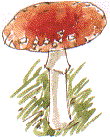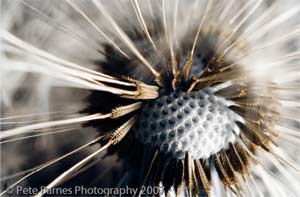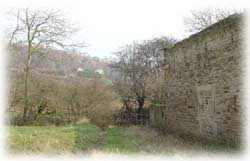
 I
haven't seen any Fly Agaric yet this year, but then I haven't
been out as much as I'd like. It often grows it near birch, for instance, by
the canal upstream from the Navigation Inn
and
the
old railway, where there are silver birches between the canal and the river.
I
haven't seen any Fly Agaric yet this year, but then I haven't
been out as much as I'd like. It often grows it near birch, for instance, by
the canal upstream from the Navigation Inn
and
the
old railway, where there are silver birches between the canal and the river.
Local photographer Pete
Barnes has been asking me where he can find
this species. Pete's portfolio ranges from people to pets but it's his landscapes
and macro-photography that I find most interesting: he's got an eye for a
design and the ability to make a striking image from something
as commonplace as a dandelion clock (right).
Can't wait to see what he makes of the magic mushrooms!
 On
the first of October, the Yorkshire
Naturalists' Union had the last day of it's 2007 Autumn Foray, this
year based on Wakefield. The conditions were bad
in Stoneycliffe Wood but there were 12
fruitbodies of the 'Old Man of the Woods' (left, in a photograph by Alan
Braddock) -
a fairly rare bolete,
formerly on the Red Data List, quite close to one of the main paths.
On
the first of October, the Yorkshire
Naturalists' Union had the last day of it's 2007 Autumn Foray, this
year based on Wakefield. The conditions were bad
in Stoneycliffe Wood but there were 12
fruitbodies of the 'Old Man of the Woods' (left, in a photograph by Alan
Braddock) -
a fairly rare bolete,
formerly on the Red Data List, quite close to one of the main paths.
The Mug Mill
 I've
been asked if I know
anything about old Mug Mill located on Smithy Brook south
of Thornhill Edge. When was it built
and who built it? It is a ruin now but it appears on a map of 1855
when it was used for milling corn. My correspondent believes
that it once belonged to a Mr. Thomas Whiteakers who paid taxes
on a corn mill in the Thornhill area in the 1670's.
I've
been asked if I know
anything about old Mug Mill located on Smithy Brook south
of Thornhill Edge. When was it built
and who built it? It is a ruin now but it appears on a map of 1855
when it was used for milling corn. My correspondent believes
that it once belonged to a Mr. Thomas Whiteakers who paid taxes
on a corn mill in the Thornhill area in the 1670's.
Wakefield Archives have found it
on Thomas Jeffries' map of the County of York (1772) where
it labelled as 'Mug Mill' and represented as a windmill-type structure.
A windmill in roughly the same location appears on maps by John Speed (drawn
1610) and
on a map by John
Saxton (drawn 1577), however they are not labeled
as being ‘Mug Mill’.
It seems unlikely that a windmill would ever be built in a valley bottom,
right next to a water supply.
Update 19 October 2019
The 'Mug Mill' is still a bit of a mystery, despite research by Nev Ashby, who confirms: 'It was a corn mill. I think it came into existence in the early 18th century, at least they were the earliest references I found in the Thornhill parish registers. I wonder if it's possible that a mill was there in 1610, but it wasn't until the early 18th century that anyone lived there.'
The Cambridge Dictionary of English Place-Names suggests 'Mogga or Mugga' as an Old English personal name, as in Mugginton, Derbyshire.
The photograph Thornhill Edge from the ruins of Mug Mill (right) is
taken from the Geograph website
© Copyright Donald Wilkinson and
licensed for reuse under this Creative
Commons Licence.

 I
haven't seen any Fly Agaric yet this year, but then I haven't
been out as much as I'd like. It often grows it near birch, for instance, by
the canal upstream from the Navigation Inn
and
the
old railway, where there are silver birches between the canal and the river.
I
haven't seen any Fly Agaric yet this year, but then I haven't
been out as much as I'd like. It often grows it near birch, for instance, by
the canal upstream from the Navigation Inn
and
the
old railway, where there are silver birches between the canal and the river. On
the first of October, the
On
the first of October, the  I've
been asked if I know
anything about old Mug Mill located on Smithy Brook south
of Thornhill Edge. When was it built
and who built it? It is a ruin now but it appears on a map of 1855
when it was used for milling corn. My correspondent believes
that it once belonged to a Mr. Thomas Whiteakers who paid taxes
on a corn mill in the Thornhill area in the 1670's.
I've
been asked if I know
anything about old Mug Mill located on Smithy Brook south
of Thornhill Edge. When was it built
and who built it? It is a ruin now but it appears on a map of 1855
when it was used for milling corn. My correspondent believes
that it once belonged to a Mr. Thomas Whiteakers who paid taxes
on a corn mill in the Thornhill area in the 1670's.